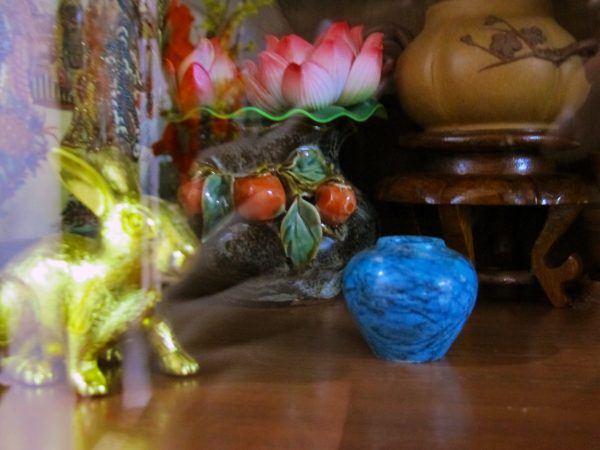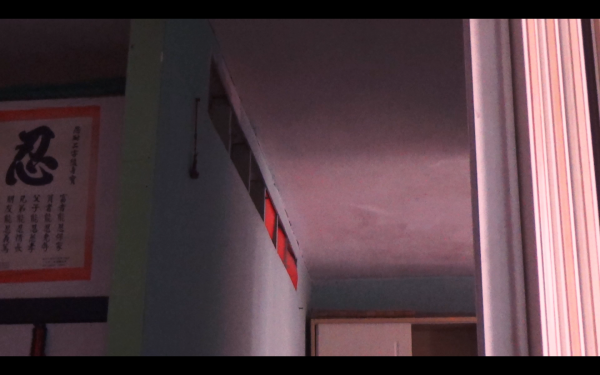“Home Making,” the 3rd edition of FP’s “Have a Balanced Diet” series initiated by FP member Ding Cheuk-laam, extends the quest for experimentation as an attitude for videography and everyday practices to key in on home-making as a site of experiment via artistic practices. What kind of habitats do we find ourselves? And what have they become when re-constructed as an expressive object to be shared by others? Ten artists will open up the magical box of their homes – via installation, single-channel video screenings, poetry and sketching.
「 間房要不要牆? 」是FP成員丁卓藍發起的《日常飲像影食》系列的第3部。繼續堅持實驗(性)不是錄影的批判與遊戲的修飾詞,而是一種整體的生活態度。房子的前題令參與的創作者定睛於熟悉而具體的日常空間;管它是做夢之地、私密的收藏,它總帶著某種程度的開放性。有牆沒牆是流通的狀態。因著創作的行動,人的主體與媒體技術的互相啟發,「家」、房間、房子、密室就成了「 打開」的起點,發聲的運動。
|| Events to note: performance – on-site exhibition – video screenings (I & II the same program) – discussion with invited guests
| 2019.07.12 (Fri) 6:00pm – 10:30pm
| 6:00 opening reception
| 6:30pm Brian Chu will perform improvised pieces with various percussion instruments, cassette feedback and sound objects.
| 7:15 錄像展覽論壇 I + 嘉賓分享 – 李智良丶梁御東 | video screening I + forum with Lee Chi-leung & Ocean Leung Yu-tung
| 2019.07.20 (Sat) 6:00pm – 9:30pm
6:00pm Brian Chu will perform improvised pieces with Wong Chung-yan.
6:45pm 錄像展覽論壇 II + 嘉賓分享 – 蔡倩怡丶楊靜丶曾泓
| video screening II +forum with Emilie Choi Sin-yi, Yang-jing & Zeng-hong
|| From the 8 participating videographers in the screening program:

陳嘉璐 Chen Jialu | 好的關係 Women’s Distance | 2019 | 25’46” |16:9 | color | sound
很顯然地,媽媽並不熟悉廚房這個空間,女兒放下行李,很自然地走向廚房,看看有什麼要可以幫忙。在廚房裡,她們都並不熟悉這個空間,但她們都自然地走向這個空間。媽媽儘量地把握這個空間,女兒儘量熟悉這個空間。只是因為媽媽想表達她的愛,女兒想回應媽媽的愛。即時兩人之間並不熟悉,卻有一份親近。我只是像一個臨時演員一樣扮演了我的身份,去配合對方完成一個場景,一個“完整”的場景。完成這個表演之後,我才去做自己的事。在場景中,我並不投入,而且清楚認識到我在配合表演。
Apparently, the mother is not familiar with the kitchen. The daughter walks towards the kitchen and sees how she can help, right after she drops her luggage. In the kitchen, they both do not know this space well, but they both walk into this space naturally. The mother tries her best to control the situation, and the daughter tries to know more about this space. Just because the mother wants to express her love, and daughter wants to respond to her love. Although they do not know each other well, they are connected.
I was like a background actor, acted as my identity and cooperated with each other to complete a scene, a perfect scene. I went back to my own work after I completed the performance. In the scene, I didn’t really enjoy it, and I clearly noticed that I was performing.
++++++++++

丁卓藍 Ding Cheuk-laam | 完好的牆 flawless wall | 2019 | 9’05” |16:9 | color | sound
在這「家」住了三年,獨自生活了一年, 由新禿禿的空間漸漸產生了痕跡。錄像裡頭,有意識地發現一年期間自己的生活跡象, 若無其事地分析自我行為, 是不由自主還是周遭環境的塑造? 我嘗試用不同敍事方法交織 , 包括對話丶說明丶詩丶第一和三人稱地闡釋。
I have lived in this apartment with my mother for three years, and then on my own for another year. Marks and traces have formed in this place that was once brand new. In this work, I retrace my life’s footprints, nonchalantly analyzing my behavior, uncertain whether I am moved involuntarily or by the force of circumstances. I attempt to intertwine different narratives, including dialogues, descriptions, poetry as well as first and third person interpretations.
++++++++++

Linda Lai 黎肖嫻 | 居所一、二 The House, The Flat (aka La Casa 1-2 | 2014 | 29′ 56″ | Visual Auto-Ethnography | color, 16:9, Las Palmas (Spain), Hong Kong
T《居所一、二》觀照居住空間的多重意義-生活的痕跡、日常創意的展示、個性的表達、個人參與歷史的方式。2001-2013年間,我把鏡頭對準西班牙丈夫渡過童年的房子和香港我爸媽居住的單位;十三年的畫面拼湊為兩個生活空間的對比性的詠賦。
丈夫幼時居住的房子構成了作品的第一部分。在拉斯帕爾馬斯的房子裡,攝錄機在家具和裝飾品上來回滑盪,又或定睛凝神細看,年續一年的,我給捲進了看、如何看、看不見的辯證旅程。我真的因為勤勞的攝錄,就能貼近這個丈夫兒時長大的空間嗎?第二部分描繪了我爸媽在香港筲箕灣的家。狹小的居室,有了母親精心排序的小擺設而生氣怏然。她自由發揮的個人美學,給小單位灌注了她的個性。
這個作品也隱約指向死亡。逝者與在世者的性情氣度,細碎的生活痕跡,唯在閒散的家居玩物中暗自呼息。這是我另一個視覺民俗誌的錄像作品,蒙太奇是我的美學座標,尋找的是另一種日常生活歷史的書寫實驗。
The House, The Flat contemplates the house as the expression of personality, as well as the ornaments that form its signature. To me, the camera and cinema have a unique role to play in archiving such imprints. Footage of the same house and flat from 2001-2013 piece together the timeless inwardness of two very different living spaces in Las Palmas, Spain and Shau Kei Wan, Hong Kong respectively.
On the interior of the bourgeois home, Walter Benjamin comments, “For the private person, living space becomes…antithetical to the place of work.” In shaping their private environment, the private citizen participates in history; they “gathers remote places and the past.” The first part of the video essay articulates my urge for intimate connections with such a space – the house in Las Palmas where my husband grew up. What could an outsider like me understand? What’s accessible is the furniture and ornaments, which my camera captures.
As my parents-in-law and my own father have passed away one after another in recent years, this video also alludes to death. They have spent their whole life embellishing their homes, but eventually they have departed/will depart one by one, leaving behind an uninhabited living space marked by their personality. But the departed live on, in the form of the material imprints that speak of their own ways of participating in history. The video essay thus shows the process of tracing the traces of those living and once lived.
++++++++++

李偉盛 Shing Lee | 團團圓 family family day | 2019 | 27’49”| 16:9 | color | stereo
家人闊別移居美國廿年的阿嫲,相聚的一刻 也是相送的一刻。本片最初為不在場的親友拍攝,以記念一屋三代人在海外終於團圓的一次旅程。
A long awaited three generations reunion with his grandma, who had emigrated to America 20 years before, was truly memorable as their first meeting became a farewell. The film was first recorded with the intention to share it with the remaining family members who could not make the trip. Accumulated grievances gradually erupted in a mundane family gathering after her passing.
++++++++++

Diana Pacheco Lagutienko | 一個島嶼的降生 Birth of an Island | 2019 | duration not defined yet | 4:3, 16:9 | color | sound
瓜亞基爾,是厄瓜多爾的主要港口也是人口最密集的城市,是在一片沼澤之中建立起來的,如今仍有很多水流從各個方向匯集於此。由於快速的經濟增長,那些環繞和侵入城市的水流——形成河流,江口,紅樹林之後變得污濁,骯髒和混亂。它們被用作商業的驅動但同時也被城市居住者們遺忘,排除在外。在當代瓜亞基爾,這些水流和邊緣化相聯繫。邊緣,儘管如此,卻仍是一個間質的空間, 可以從中收集城市的文化奇點。
在寫給中國友人的一封信裡,我想像這座島嶼和某種另類的家:一個無法避免和城市發生關係的空間,但是遠離它狂躁的節奏,一個不穩定的允許記憶從沈澱中不斷建構的空間。通過這個研究項目,我將收集可以讓我使用數據和記憶來繪製這個島嶼的檔案資料。我建議以想像力的殖民來代替物理性的侵入,以此來重新想像和城市的關係。
Guayaquil, the main port and most populated Ecuadorian city, was built on a swamp and receives water from many directions. Due to fast economic growth, the waters that surround and invade the city – rivers, estuaries and mangroves – have become stagnant, dirty and turbid. They are used as a commercial engine but at the same time, forgotten and excluded by the city dwellers. In contemporary Guayaquil, these waters are connected with the idea of marginality. The marginal, nonetheless, is an interstitial space in which it is possible to collect, as sediment, cultural singularities of the city.
In a letter to a friend in China, I imagine this island as my alternative home: a space inevitably linked to the city but distant from its frenetic rhythm, an unstable space which allows building up sedimentary memories. In this research project, I collect archive pieces that allow me to map the island though data and memories. I propose a hypothetical colonization, where instead of invading a physical place, we use it to reimagine a relationship with the city.
++++++++++

黃頌恩 Wong Chung-yan | 組合:模型:時空玩具 building blocks | 2019 | 30’08” | color | no subtitles
爺爺與物件逐漸搬離開1989年居住的大窩口公屋邨單位,空間裡儲藏的家族概念以物的消失呈現彌散,喪失組織。保存了家庭團聚的地方變回一個無足輕重的租用單位。
錄像舉辨一場空間敘事,意識帶領著地方記住它獨特的放置、結構及痕跡。思考空間,以及自己對家庭觀感的意識重建與保存。
游走於偶然醒起而保留的感受經驗,短途旅行。
I recorded my grandfather’s gradual move from the public estate he had lived in for 30 years. During the period, the concept of family stored in the space ebbed away as the objects slowly disappeared. A 400 square feet space for family reunions slowly changed back into an insignificant rental unit.
Through the reconstruction of the unique placements, structures and traces in the house, I remembered my time in this space. I ponder over the space, and my family outlook, to better rebuild and preserve them.
I wander through, occasionally waking up to the lingering sensations and experiences, a short journey.
++++++++++

黃慧心 Winsome Wong | Afternoons | 2017 | 25’01” | 16:9 | color | stereo
小學之後不再與爺爺嫲嫲同住,嫲嫲也搬到老人院,隨著身體越漸衰弱也越來越少回家。有時探望他們,嫲嫲也在家的話,就享受在舊居百無聊賴,主要是嫲嫲說話、重複著話題的下午。 有時就分開探望老人院的嫲嫲,和住在附近但也不太方便走太遠路探望嫲嫲的爺爺。
2016 做了作品的第一部份,記錄了在爺爺家的一個下午,和與爺爺嫲嫲不同時候在老人院和舊居的對話,那時並沒有仔細分析那些對話。2019年偶爾有一晚回看這段影片,同樣沒有怎麼分析對話內容,就是很舒服的聽著嫲嫲的聲音,像收音機一樣。我於是決定再回顧一遍,加上嫲嫲過世後的一些下午的片段,好好認真紀錄一遍。
I don’t live with my grandparents anymore since I graduated from primary school. And my grandma has moved to the home for the aged since then, as her physical condition got weaker and weaker, she stayed home less frequent. Sometimes when I visited them, if grandma was also there, we would spend an afternoon basically doing nothing much, mainly with my grandma talking, repeating similar topics. Sometimes I would visit them separately, I would first visit grandma at the home for the aged, and then grandpa, who lives near by but would be difficult for him to walk too far to visit grandma, or maybe vice versa.
In 2016, I made the first part of the video, recording one afternoon in grandpa’s home, and the conversations of different times at grandpa’s home and the home for the aged. At that time, I didn’t intend to analyse the conversations in detail. Then in 2019, I occasionally watched the video again one night, I still didn’t pay much attention to the content of the conversations, I was just listening to grandma’s voice comfortably like listening to the radio. Then, I decided to go through it once again, together with the afternoon moments after my grandma passed away, to take it serious and record what were once being said.
++++++++++

張子木 Zimu Zhang | 小北来信 Letter from Xiaobei | 2017 | 9’05” |16:9 | color | sound
通過視頻信件的形式,我給遠在厄瓜多爾的摯友Diana寫信,講述我在廣州黑人社區的經歷。這封信使我得以回看過去,產生新的思緒。
這是一個自我檢視的過程,也是一個輕柔的微觀歷史改寫;;一個日常的家之建構的漫遊。
Through a video letter, I told my dear friend Diana in Ecuador about my experience in Guangzhou’s African community in Xiaobei. The letter also shows me looking back at the past while reflecting on the present.
It’s a self-inspection while also gently revising the past; an everyday walk through of home making.
++++++++++
|| Guest Discussants
2019.07.12
李智良,著有詩/小說集《白瓷》、散文集《房間》及攝影誌《海邊草更藍》。
Lee Chi-Leung. Author/ Photographer. His works include Porcelain, A Room Without Myself, and Grass is Bluer by the Sea.
Link to his recent work 【無形.噪音】畫音串擾 in 虛詞 p-articles […]
梁御東在香港生活及工作。他從游蕩和觀察出發,以現成物件、裝置和錄像呈現對當代生活的省思,並尋找表達的侷限。梁氏曾於「咩事藝術空間」作藝術家駐留及展出(2015);2016年於香港中文大學藝術碩士(藝術創作)課程畢業,同年於「安全口」畫廊舉辦個人展覽《捲起燦爛低溫》。此外參與策劃《遊園誌》聯展(第六屆藝遊鄰里計劃,香港視覺藝術中心,2017)、 《殺到油麻地!地區自救計劃暨展覽示範》(活化廳,2012)及《P-at-Riot : 80後六四文化祭》 (2009) 。同時他是紀錄片《收割,開路!》 (2015)及 《稻米是如何鍊成的》(2013)的監製 。
Ocean Leung lives and works in Hong Kong. His art practices are often in the form of object, installation and video. Trying to be inspired by street drifting and observation on everyday life, his works appear to be an interplay on the relationship between art and its plights. Ocean was the residency artist in Things that can happen art space in the winter of 2015. Graduated from Master of Fine Arts program in The Chinese University of Hong Kong in 2016, Gallery Exit featured his solo exhibition “Roll up the vibrant breeze” in the same year. Ocean co-curated some art projects, “No Neverland”(2017), “Yau Ma Tei Self-Rescue Project & Demonstrative Exhibition” (Wooferten, 2012) and “P-at-Riot: June Fourth Festival for Post-80s Generation” (2009). He is also an independent documentary film producer, participating in “The Way of Paddy” (2013) and “Open Road After Harvest” (2015), two documentary films about organic agriculture and activism in Hong Kong.
2019.07.20
Dr. Zeng Hong, art and film scholar, curator, based in Hong Kong;
曾泓博士,藝術及電影學者、策展人,現居香港。
楊靜生於新疆烏魯木齊市,在上海、香港和德國多地求學。目前她是海德堡大學全球藝術史系的博士候選人。在學術研究以外,她還擔任過:學術出版編輯、國際新聞記者、遊戲藝術策展人。她關注的領域是電子遊戲、當代藝術和新媒體的重疊部分,剛剛完成深圳國際獨立動畫雙年展中遊戲部分的策展工作。
Yang Jing, writer, curator, gamer. Yang Jing was born in Urumqi, the capital city of China’s northwest province Xinjiang. She studies and works in Shanghai, Hong Kong and Germany. Right now she is a PhD candidate in Global Art History in Heidelberg University.
Yang works in various fields: an academic editor, a journalist of an international news desk, a researcher as well as a teacher. In recent years, she began to learn the art of focus, and narrowed her interests to the intersection of game, art, media and research. Currently, she writes and reviews game and art, manages the game channel Game On in Initium Media, and contributes to her own column Strange Stories from Allison’s Studio. When she is not writing, she is exploring other ways of creative and critical expression; recent adventures include curating (Video Game: Cohabitant in 2018 Shenzhen International Independent Animation Biennale), as well as podcasting (The Unemployable).
蔡倩怡。影像研究者、書寫的人。映畫手民編輯及Floating Projects成員,曾策劃紀錄片專題回顧展及其他相關影像項目。前媒體文化版記者。本科文化研究,半途修讀視覺藝術。關注亞洲另類影像、紀錄片、當代藝術與電影的交錯關係、影像歷史與政治、影展研究及文化研究。熱愛影像與媒介的考古挖掘。相信從影像的研究、策展、出版,以至檔案紀錄來構築知識生產,與介入公共空間。最近寫關於香港實驗影像史的研究論文,及籌劃Floating EYES計劃,情迷眼的意象。
CHOI Sin-yi (Emilie) is a Hong Kong-based researcher, curator and critic concentrating on film art, moving images and time-based media in general. She worked as a cultural journalist for several years. She is the editor of Cinezen and the member of Floating Projects. She has curated a documentary retrospective programme and also participated in various moving image projects.
Emilie’s research interests include the practice of moving image (in particular Asian documentary, experimental and alternative cinema and video art), image politics and history, film festivals, the intricate relationship between art and cinema as well as cultural studies. She is also passionate about media archaeology. She believes that research, curating, publication and archiving is a process of knowledge-mapping and creation of publics. She is writing her thesis on the history of Hong Kong experimental practices of moving image art, working on the project of “Floating EYES” and she is immersed into the symbol of eyes.






